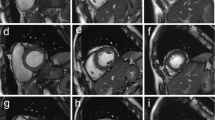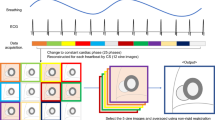Abstract
Objectives
Residual respiratory motion degrades image quality in conventional cardiac cine MRI (CCMRI). We evaluated whether a free-breathing (FB) radial imaging CCMRI sequence with compressed sensing reconstruction [extradimensional (e.g. cardiac and respiratory phases) golden-angle radial sparse parallel, or XD-GRASP] could provide better image quality than a conventional Cartesian breath-held (BH) sequence in an unselected population of patients undergoing clinical CCMRI.
Materials and methods
One hundred one patients who underwent BH and FB imaging in a midventricular short-axis plane at a matching location were included. Visual and quantitative image analysis was performed by two blinded experienced readers, using a five-point qualitative scale to score overall image quality and visual signal-to-noise ratio (SNR) grade, with measures of noise and sharpness. End-diastolic and end-systolic left ventricular areas were also measured and compared for both BH and FB images.
Results
Image quality was generally better with the BH cines (overall quality grade for BH vs FB images 4 vs 2.9, p < 0.001; noise 0.06 vs 0.08 p < 0.001; SNR grade 4.1 vs 3, p < 0.001), except for sharpness (p = 0.48). There were no significant differences between BH and FB images regarding end-diastolic or end-systolic areas (p = 0.35 and p = 0.12). Eighteen of the 101 patients had poor BH image quality (grade 1 or 2). In this subgroup, the quality of the FB images was better (p = 0.0032), as was the SNR grade (p = 0.003), but there were no significant differences regarding noise and sharpness (p = 0.45 and p = 0.47).
Conclusion
Although FB XD-GRASP CCMRI was visually inferior to conventional BH CCMRI in general, it provided improved image quality in the subgroup of patients with respiratory-motion-induced artifacts on BH images.




Similar content being viewed by others
References
Pennell DJ, Sechtem UP, Higgins CB et al (2004) Clinical indications for cardiovascular magnetic resonance (CMR): consensus panel report. Eur Heart J 25(21):1940–1965
Hundley WG, Bluemke DA, Finn JP et al (2010) ACCF/ACR/AHA/NASCI/SCMR 2010 expert consensus document on cardiovascular magnetic resonance: a report of the American College of Cardiology Foundation Task Force on Expert Consensus Documents. J Am Coll Cardiol 55(23):2614–2662
Ferreira PF, Gatehouse PD, Mohiaddin RH, Firmin DN (2013) Cardiovascular magnetic resonance artefacts. J Cardiovasc Magn Reson 15:41
Saloner D, Liu J, Haraldsson H (2015) MR physics in practice: how to optimize acquisition quality and time for cardiac MR imaging. Magn Reson Imaging Clin N Am 23(1):1–6
van Heeswijk RB, Bonanno G, Coppo S, Coristine A, Kober T, Stuber M (2012) Motion compensation strategies in magnetic resonance imaging. Crit Rev Biomed Eng 40(2):99–119
Feng L, Axel L, Chandarana H, Block KT, Sodickson DK, Otazo R (2016) XD GRASP: golden-angle radial MRI with reconstruction of extra motion-state dimensions using compressed sensing. Magn Reson Med 75(2):775–788
Chen C, Li Y, Axel L, Huang J (2016) Real time dynamic MRI by exploiting spatial and temporal sparsity. Magn Reson Imaging 34(4):473–482
Wech T, Pickl W, Tran-Gia J, Ritter C, Beer M, Hahn D, Köstler H (2014) Whole-heart cine MRI in a single breath-hold—a compressed sensing accelerated 3D acquisition technique for assessment of cardiac function. Rofo 186(1):37–41
Weber MA (2013) Magnetic resonance imaging of the skeletal musculature. Springer, Berlin
Glover GH, Pauly JM (1992) Projection reconstruction techniques for reduction of motion effects in MRI. Magn Reson Med 28(2):275–289
Rudin LO, Osher S, Fatemi E (1992) Nonlinear total variation based noise removal algorithms. Physica D 60(1–4):259–268
Adluru G, Awate SP, Tasdizen T, Whitaker RT, Dibella EV (2007) Temporally constrained reconstruction of dynamic cardiac perfusion MRI. Magn Reson Med 57(6):1027–1036
Block KT, Uecker M, Frahm J (2007) Undersampled radial MRI with multiple coils. iterative image reconstruction using a total variation constraint. Magn Reson Med 57(6):1086–1098
Lustig M, Santos M, Donoho D, Pauly JM (2006) k-t SPARSE: high frame rate dynamic MRI exploiting spatio-temporal sparsity. In: Proceedings of the 13th Annual Meeting of ISMRM, vol 50, No. 5. Seattle, p 2420. http://cds.ismrm.org/ismrm-2006/files/02420.pdf
Thompson RB, McVeigh ER (2006) Cardiorespiratory-resolved magnetic resonance imaging: measuring respiratory modulation of cardiac function. Magn Reson Med 56(6):1301–1310
Lustig M, Donoho D, Santos J, Pauly JM (2008) Compressed sensing MRI. IEEE Signal Process Mag 25(2):72–82
Lustig M, Donoho D, Pauly JM (2007) Sparse MRI: the application of compressed sensing for rapid MR imaging. Magn Reson Med 58(6):1182–1195
Babacan SD, Peng X, Wang XP, Do MN, Liang ZP (2011) Reference-guided sparsifying transform design for compressive sensing MRI. Conf Proc IEEE Eng Med Biol Soc 2011:5718–5721. doi:10.1109/IEMBS.2011.6091384
Smith DS, Li X, Abramson RG, Quarles CC, Yankeelov TE, Welch EB (2013) Potential of compressed sensing in quantitative MR imaging of cancer. Cancer Imaging 13(4):633–644
Zibetti MVW, De Pierro AR (2017) Improving compressive sensing in MRI with separate magnitude and phase priors. Multidim Syst Sign Process 28:1109. doi:10.1007/s11045-016-0383-6
Candes EJ, Wakin MB (2008) An introduction to compressive sampling. IEEE Signal Process Mag 25(2):21–30
Ahmad R, Ding Y, Simonetti OP (2015) Edge sharpness assessment by parametric modeling: application to magnetic resonance imaging. Concepts Magn Reson Part A 44(3):138–149
Xue Y, Yu J, Kang HS, Englander S, Rosen MA, Song HK (2012) Automatic coil selection for streak artifact reduction in radial MRI. Magn Reson Med 67(2):470–476
Chan RW, Ramsay EA, Cheung EY, Plewes DB (2012) The influence of radial undersampling schemes on compressed sensing reconstruction in breast MRI. Magn Reson Med 67(2):363–377
Riffel P, Zoellner FG, Budjan J et al (2016) “One-stop shop”: free-breathing dynamic contrast-enhanced magnetic resonance imaging of the kidney using iterative reconstruction and continuous golden-angle radial sampling. Investig Radiol 51(11):714–719
Lin W, Huang F, Simonotto E, Duensing GR, Reykowski A (2012) Off-resonance artifacts correction with convolution in k-space (ORACLE). Magn Reson Med 67:1547–1555
Wei Li W, Storey P, Chen Q, Li BSY, Prasad PV, Edelman RR (2004) Dark flow artifacts with steady-state free precession cine MR technique: causes and implications for cardiac MR imaging. Radiology 230:569–575
Pang J, Sharif B, Fan Z et al (2014) ECG and navigator-free four-dimensional whole-heart coronary MRA for simultaneous visualization of cardiac anatomy and function. Magn Reson Med. doi:10.1002/mrm.25450
Contijoch F, Iyer SK, Pilla JJ et al (2016) Self-gated MRI of multiple beat morphologies in the presence of arrhythmias. Magn Reson Med. doi:10.1002/mrm.26381
Piekarski E, Chitiboi T, Ramb R, Feng L, Axel L (2016) Use of self-gated radial cardiovascular magnetic resonance to detect and classify arrhythmias (atrial fibrillation and premature ventricular contraction). J Cardiovasc Magn Reson 18(1):83
Huang RY, Dung LR (2016) Measurement of heart rate variability using off-the-shelf smart phones. Biomed Eng Online 15:11
Ruan X, Liu C, Li P (2011) Detection of atrial fibrillation using R-R interval signal. In: 4th international conference on biomedical engineering and informatics, BMEI 2011, Shanghai, China, October 15–17, 2011, at Shanghai, China. doi: 10.1109/BMEI.2011.6098492
Francone M, Dymarkowski S, Kalantzi M, Bogaert J (2005) Real-time cine MRI of ventricular septal motion: a novel approach to assess ventricular coupling. J Magn Reson Imaging 21(3):305–309
Author information
Authors and Affiliations
Contributions
EP participated in the data collection and the data analysis and wrote the manuscript. TC participated in the data collection and the data analysis and reviewed the manuscript. RR participated in the data analysis and reviewed the manuscript. LAL participated in the data collection and reviewed the manuscript. PB participated in the data collection and reviewed the manuscript. LF participated in the protocol development and reviewed the manuscript. LA designed the project development, participated in the data analysis, and redacted and reviewed the manuscript.
Corresponding author
Ethics declarations
Funding
This study was funded by the NIH (Grant Number NIH R21-EB109595-01).
Conflict of interest
The authors declare that they have no competing interests.
Research involving human participants and informed consent
This retrospective study was approved by our institutional review board and was performed according to standards of the Health Insurance Portability and Accountability Act. Documentation of consent was waived.
Rights and permissions
About this article
Cite this article
Piekarski, E., Chitiboi, T., Ramb, R. et al. Two-dimensional XD-GRASP provides better image quality than conventional 2D cardiac cine MRI for patients who cannot suspend respiration. Magn Reson Mater Phy 31, 49–59 (2018). https://doi.org/10.1007/s10334-017-0655-7
Received:
Revised:
Accepted:
Published:
Issue Date:
DOI: https://doi.org/10.1007/s10334-017-0655-7




